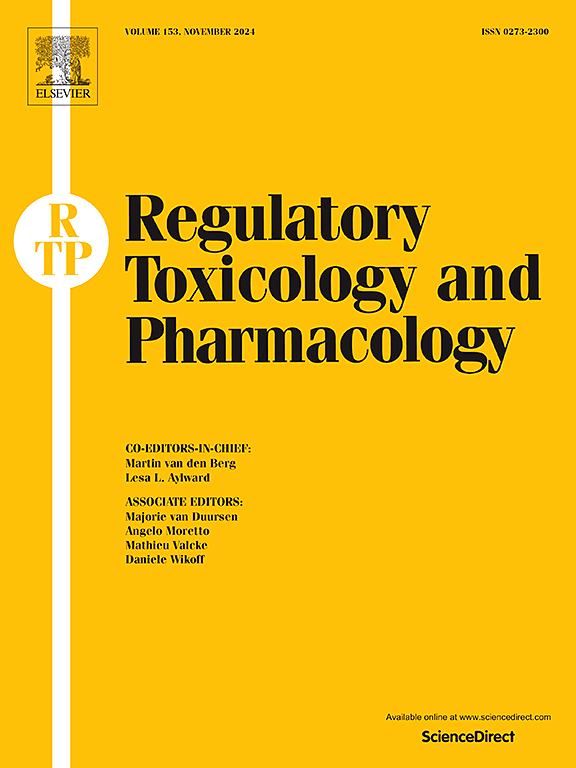Using data on the uncertainty of LOAELs to model the probability of observing adverse effects in low-dose studies of the toxicity of chemical mixtures
IF 3
4区 医学
Q1 MEDICINE, LEGAL
引用次数: 0
Abstract
Studies of chemical mixtures toxicity are often designed to differentiate mixtures that follow dose-addition from those that follow response-addition. One design used for this purpose doses animals at levels below the levels that separately have been shown to cause a detectable occurence of a common effect. Under response addition, no effects are expected to be observed since no chemical would independently cause an observable response at the administered doses. Effects, however, could be observed if some or all of the chemicals follow dose addition. Thus, any observation of response can be taken as evidence of dose addition. A recent publication estimated interstudy variation in chemicals’ LOAELs. These estimates are here used to predict the probability of observing an effect in mixtures that follow response- or dose-addition models. Two case studies are presented. One is on a set of hypothetical mixtures containing from 2 to 20 chemicals. The second is on mixtures of anti-androgenic chemicals. In these studies, LOAEL uncertainty blurred the difference between dose and response models, and for many mixtures, it is not possible to determine whether response or dose additivity occurred. These findings suggest that caution should be taken when using these studies as evidence for dose addition.
利用loel不确定度的数据模拟在低剂量化学混合物毒性研究中观察到不良反应的可能性
化学混合物的毒性研究通常是为了区分剂量加和反应加的混合物。为此目的使用的一种设计是,给动物的剂量低于已被证明会引起可检测到的共同效应的水平。在反应附加下,预期不会观察到任何效应,因为在给药剂量下,没有任何化学物质会单独引起可观察到的反应。然而,如果部分或全部化学物质按照剂量增加,则可以观察到效果。因此,任何观察到的反应都可以作为剂量增加的证据。最近的一份出版物估计了化学物质的水平水平在研究间的差异。这些估计值在这里用于预测在遵循响应或剂量增加模型的混合物中观察到效应的概率。提出了两个案例研究。一种是假设含有2到20种化学物质的混合物。第二个是关于抗雄激素化学物质的混合物。在这些研究中,LOAEL不确定性模糊了剂量和反应模型之间的差异,并且对于许多混合物,无法确定是否发生了反应或剂量可加性。这些发现表明,在使用这些研究作为增加剂量的证据时应谨慎。
本文章由计算机程序翻译,如有差异,请以英文原文为准。
求助全文
约1分钟内获得全文
求助全文
来源期刊
CiteScore
6.70
自引率
8.80%
发文量
147
审稿时长
58 days
期刊介绍:
Regulatory Toxicology and Pharmacology publishes peer reviewed articles that involve the generation, evaluation, and interpretation of experimental animal and human data that are of direct importance and relevance for regulatory authorities with respect to toxicological and pharmacological regulations in society. All peer-reviewed articles that are published should be devoted to improve the protection of human health and environment. Reviews and discussions are welcomed that address legal and/or regulatory decisions with respect to risk assessment and management of toxicological and pharmacological compounds on a scientific basis. It addresses an international readership of scientists, risk assessors and managers, and other professionals active in the field of human and environmental health.
Types of peer-reviewed articles published:
-Original research articles of relevance for regulatory aspects covering aspects including, but not limited to:
1.Factors influencing human sensitivity
2.Exposure science related to risk assessment
3.Alternative toxicological test methods
4.Frameworks for evaluation and integration of data in regulatory evaluations
5.Harmonization across regulatory agencies
6.Read-across methods and evaluations
-Contemporary Reviews on policy related Research issues
-Letters to the Editor
-Guest Editorials (by Invitation)

 求助内容:
求助内容: 应助结果提醒方式:
应助结果提醒方式:


